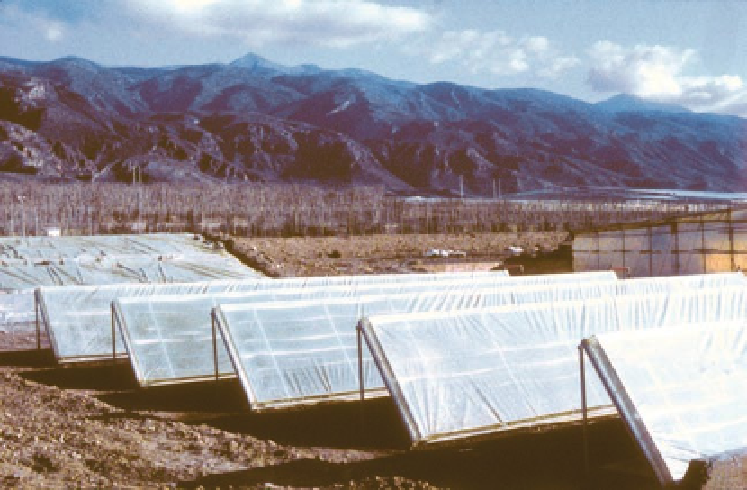Agriculture Reference
In-Depth Information
cogeneration usually supplies heat and
electricity in a proportion of two to one (Van
de Braak, 1995). It is also popular when it is
possible to sell the electricity produced at
attractive prices, as has happened in Europe
in recent years.
of 16°C (ASAE, 2002) covers the require-
ments of most plants and the external tem-
perature (
T
e
) is the average of the minimum
temperatures of the coldest month.
7.4.6
Heating and temperature
management
Solar energy
Solar energy is free, available, excessive in
summer but insufficient in winter, and
requires high investments for its capture,
and above all, its storage (Photo 7.6).
In general, the optimum temperatures
decrease with the age of the plant and vary
depending on the process that we want to
optimize (translocation, gross photosynthe-
sis, root growth, harvest) (Hanan, 1998).
With a higher temperature, of the order of
22-23°C, vegetative growth is activated in
vegetables such as tomato, whereas lower
values (18-19°C) favour fruit development
(Kamp and Timmerman, 1996). The opti-
mum temperature also depends on the radi-
ation and CO
2
concentration in the air (see
Chapter 6).
Although plants have a great capacity
to integrate the temperatures in periods
larger than 24 h, it is necessary not to over-
come certain thermal limits, which usually
range between 10 and 25°C for horticultural
species. In general, if the temperatures are
lower than the optimum there will be less
Biogas
Biogas has not been developed due to the
low costs of conventional energy. The high
proportion of CO
2
in biogas causes poor
flame performance.
7.4.5
Sizing of the heating systems
See Chapter 5 Section 5.4 ('Simplified
Greenhouse Energy Balances').
For the purpose of calculating the max-
imum heating requirements it is estimated
that an internal greenhouse temperature (
T
i
)
Photo 7.6.
Low-cost solar panels for greenhouse heating (experimental Station 'Las Palmerillas', Almeria).

